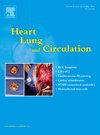Practice Change in Surgical Treatment Strategies for Ischaemic Mitral Regurgitation and Late Outcomes
IF 2.2
4区 医学
Q2 CARDIAC & CARDIOVASCULAR SYSTEMS
引用次数: 0
Abstract
Background
Ischaemic mitral regurgitation (IMR) results from dysfunctional myocardial remodelling, which portends a poor clinical prognosis. This study assessed the surgical treatment of IMR and its associations with clinical and echocardiographic outcomes in the context of 2014 reports suggesting non-surgical management of non-severe IMR.
Method
Patients who underwent mitral valve (MV) procedures for IMR at Liverpool Hospital (Sydney, Australia) between 2008 and 2020 were included based on coronary disease and echocardiographic criteria. Data were obtained from patient records and linkage with the Australian Institute of Health and Welfare National Death Index. The primary outcome was the type of MV surgery performed in 2008–2014 and 2015–2020. Secondary outcomes were survival and freedom from combination of mortality and congestive heart failure (CHF) readmission, comparing MV repair and MV replacement and the outcomes for two periods by MV procedure.
Results
Of 106 patients treated surgically for IMR, 78 had MV repair (59 in 2008–2014, 19 in 2015–2020) and 28 had MV replacement (14 in 2008–2014, 14 in 2015–2020). Patients were followed up for 7.2 years (interquartile range 5.2–9.1). Compared to 2008–2014, there was a reduced proportion of MV procedures for IMR (4.2% and 2.0%; p<0.001) and MV repair for IMR (80.8% and 57.6%; p=0.012) post-2014. Freedom from a combination of mortality and CHF readmission over 10 years was significantly better in the MV repair than in the MV replacement group (log rank p<0.001). Over 5 years, freedom from mortality and the combination of mortality and CHF readmission were similar in both periods (log rank p=0.675 and p=0.433). In the earlier period, freedom from combined outcome was better in the MV repair group than the MV replacement group (log rank p<0.001) but not different in the second period (log rank p=0.149). Mitral regurgitation recurrence was less in the later period (25.8% and 3.6%; p=0.013).
Conclusions
The proportion of MV procedures and MV repairs performed for IMR declined significantly after 2014, indicating a significant change in practice towards conservative surgical correction of IMR. The combined long-term outcomes were unchanged after the change in practice, but the incidence of mitral regurgitation recurrence was significantly improved.
缺血性二尖瓣返流手术治疗策略的实践变化及晚期预后。
背景:缺血性二尖瓣反流(IMR)是由心肌重构功能障碍引起的,预示着不良的临床预后。本研究评估了2014年报告中建议非手术治疗非严重IMR的手术治疗及其与临床和超声心动图结果的关系。方法:根据冠状动脉疾病和超声心动图标准纳入2008年至2020年间在利物浦医院(澳大利亚悉尼)接受二尖瓣(MV)手术的IMR患者。数据来自患者记录,并与澳大利亚健康和福利研究所国家死亡指数联系。主要结局是2008-2014年和2015-2020年进行的MV手术类型。次要结果是生存和免于合并死亡和充血性心力衰竭(CHF)再入院,比较中压修复和中压置换以及两期中压手术的结果。结果:106例手术治疗IMR的患者中,78例进行了中压修复(2008-2014年59例,2015-2020年19例),28例进行了中压置换(2008-2014年14例,2015-2020年14例)。患者随访7.2年(四分位数范围5.2-9.1)。与2008-2014年相比,IMR的MV手术比例有所下降(4.2%和2.0%;结论:2014年以后,中压手术和中压修复治疗IMR的比例明显下降,表明实践中对IMR保守性手术矫正的态度发生了重大变化。术后远期综合疗效无变化,但二尖瓣返流发生率明显改善。
本文章由计算机程序翻译,如有差异,请以英文原文为准。
求助全文
约1分钟内获得全文
求助全文
来源期刊

Heart, Lung and Circulation
CARDIAC & CARDIOVASCULAR SYSTEMS-
CiteScore
4.50
自引率
3.80%
发文量
912
审稿时长
11.9 weeks
期刊介绍:
Heart, Lung and Circulation publishes articles integrating clinical and research activities in the fields of basic cardiovascular science, clinical cardiology and cardiac surgery, with a focus on emerging issues in cardiovascular disease. The journal promotes multidisciplinary dialogue between cardiologists, cardiothoracic surgeons, cardio-pulmonary physicians and cardiovascular scientists.
 求助内容:
求助内容: 应助结果提醒方式:
应助结果提醒方式:


